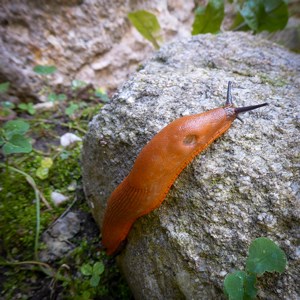Contact
 Maria Viketoft
Maria Viketoft
Researcher at the Department of Ecology
maria.viketoft@slu.se
Telephone: 018 -67 1505
CV-page

For the first time, a survey of slug-parasitic worms was conducted in Sweden. Parasitizing worms could potentially reduce the size of slug populations that cause yield losses in agriculture, such as the Spanish slug. The two dominant worm species found in the slugs has never been recorded in Sweden until now.
Slugs are important economic pests of several crops and are a serious threat to agricultural and horticultural production. Climate change with milder winters and warmer and wetter growing seasons will benefit the slug populations.
– In the past, the grey field slug was the species of greatest economic importance in Europe and often caused damage of greater economic significance than insects. In recent decades, however, the invasive Spanish slug has spread throughout Europe becoming an established pest both in home gardens and agricultural crops, says Maria Viketoft, one of the authors behind the study.
Swedish farmers have reported increasing economic damage from slugs, but expensive molluscicides are economically infeasible as a mode of control. However, slug parasitic worms such as nematodes (roundworms inhabiting a broad range of environments) and trematodes (flatworms that only live inside other organisms) could provide natural biological control. Today, there are two commercial biological molluscicides on the market, but in Sweden only the use of the worm Phasmarhabditis hermaphrodita (sold under the name Nemaslug®) is approved
– In this study we wanted to quantify the occurrence of nematodes and trematodes
in slugs from agricultural field edges. This is the first study attempting to identify slug-parasitic worms in Sweden. In total, we collected 268 terrestrial slugs from 27 agricultural field edges in three seasons over 2020 and 2021, says Maria.
Overall, 13% of the collected slugs had worm parasites and the likelihood of a slug being parasitized was highest in autumn. The Spanish slug was also more likely to be parasitized than native slug species. The prevalence of nematodes and trematodes were similar; the dominant species found were Alloionema appendiculatum and Brachylaima thompsoni, respectively.
– This is the first record of the presence of these two species in Sweden. They are not lethal to the slugs, but further studies on slug-parasitic worms in other types of habitats may render other worm species that are good candidates to be biological control agents to combat slugs that cause economic losses, says Maria.
 Maria Viketoft
Maria ViketoftResearcher at the Department of Ecology
maria.viketoft@slu.se
Telephone: 018 -67 1505
CV-page
Read the full story “Helminths associated with terrestrial slugs in Swedish agricultural fields” in the scientific journal Journal of Helminthology.